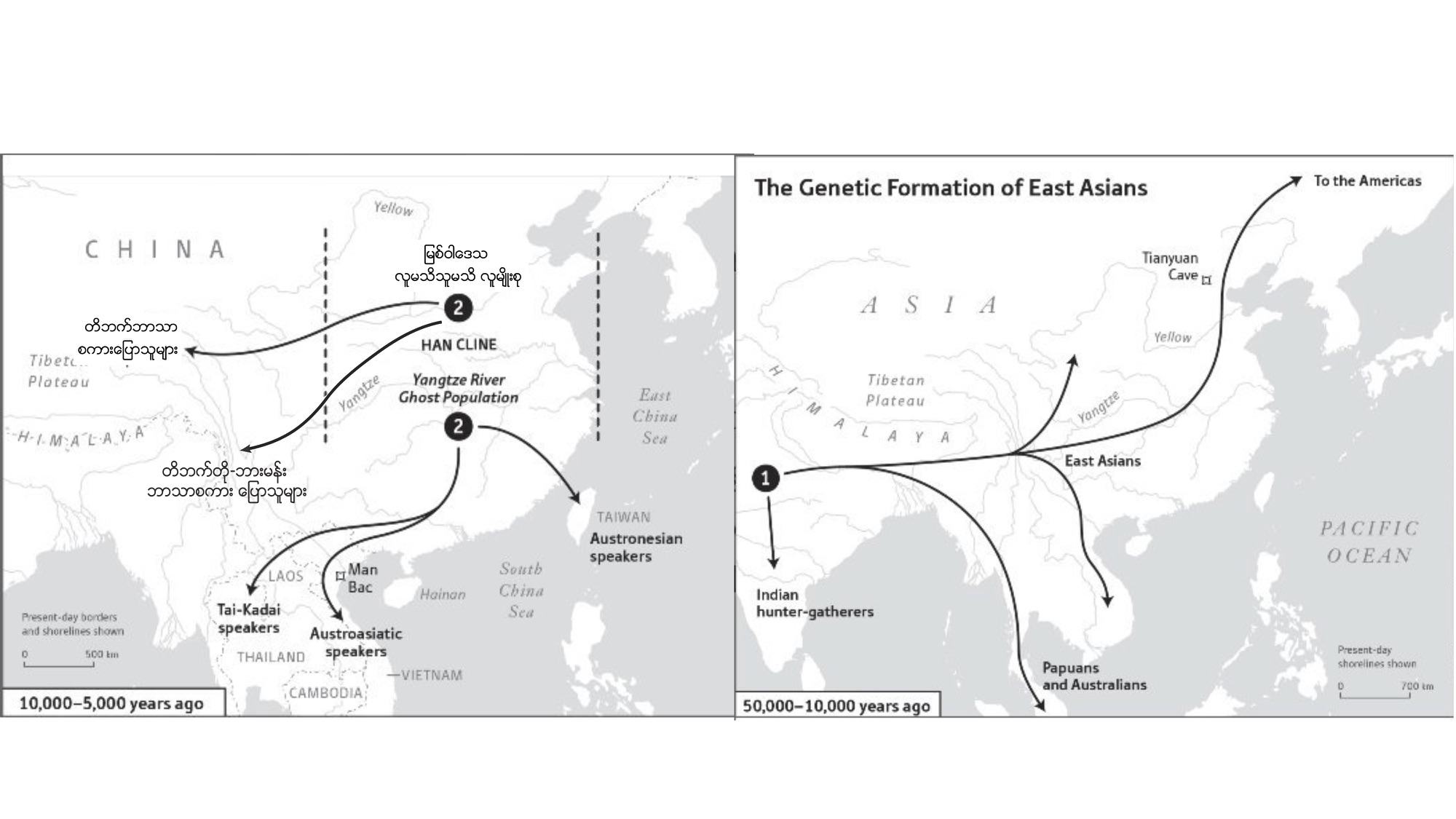
The genetic history of the Burmese people
In recent years there has been a revolution in genetic science. Scientists are now able to unlock new information about humanity's distant past in a way that was impossible before. Over the coming years, much more information might be uncovered about the genetic history of Myanmar than is known today. This is a summary of what seems to be known so far: (Note: "Burmese" refers to the ethnic majority Burmese-speaking people of the Irrawaddy valley.)
Anatomically modern humans (physically almost the same as today's humans) evolved in Africa around 200,000 years BP ("Before Present"). These first modern humans left Africa probably in two waves: around 120,000 BP and 60,000 BP. All people in Europe, Asia and America, are descended from the second wave.
Around 60,000 BP modern humans went east to India, Myanmar, and eventually Australia. Another group probably went north into what is today central Asia. At that time, Europe and Asia were home to not just modern humans but other related species as well: Neanderthals in Europe, Denisovans in Asia, maybe Homo Erectus and Hobbits in Indonesia. Sea levels were then much lower than today. Most of what is today Southeast Asia was one region, all connected by land - this region is referred to as "Sundaland" and, by 20,000 BP, may have been one of the most populous places in the world.
From 60,000-10,000 BP Myanmar was inhabited by small groups of hunter-gatherers, probably similar to other groups in Sundaland. No one knows what they looked like. It is important to remember though that until 50,000 BP to 10,000 BP, people in different parts of the world may have looked entirely different than they do today.
From Sundaland, people migrated north to what is now China and then onwards to Siberia, east to America, and west to Europe.
Around 10,000 BP, the Ice Age ended, dramatically changing climate conditions across Europe and Asia. Myanmar was connected to the Andaman Islands by a land bridge which flooded at this time. The people on the Andaman Islands today are descended from hunter-gatherers who lived in Myanmar and were then trapped there when this bridge flooded.
Around 7,000 BP in what is today China, there were two distinct populations that are now extinct. Referred to as "ghost populations", one lived along the Yellow River and developed millet farming while the other lived along the Yangtze River and developed rice farming. The Yellow River ghost population may have spoken a language ancestral to Burmese, Tibetan, and Chinese while the Yangtze River ghost population likely spoke a language ancestral to Munda (in India), Mon, Cambodian, and Vietnamese. The Yangtze River ghost population moved south around 4,000 BP and mixed with Southeast Asian hunter-gatherers - most Southeast Asians today, are the result of this mix.
The Burmese, however, are a little different. This is increasingly clear from recent genetic research. Sometime around 4,000 BP, the first farmers arrived from what is now southwest China - likely an offshoot of the Yellow River ghost population. They then mixed with the Southeast Asian hunter-gatherers who had been here for tens of thousands of years. So whereas most Southeast Asians around 4,000 BP were a mix of Yangtze River ghost population and Southeast Asian hunter-gatherers; people in Myanmar were a mix of the Yellow River ghost population and southeast hunter-gatherers.
Around 2,000 BP a third group arrived: bronze age people (mainly men) speaking Tibeto-Burman languages. They were probably genetically close to Tibetans and the Yellow River ghost population. These bronze-age migrants then mixed with the groups already there. One Tibeto-Burman language, Pyu, became dominant in most of the Irrawaddy valley.
Then, around 1,000 BP, came an additional element: the Burmese language. Burmese is part of the Yi-Burmese subgroup of the Tibeto-Burman language family. While it is related to Tibetan, it is much more closely related to Yi, spoken today in western Yunnan and southern Sichuan. (Lisu is an Yi language.) The exact relationship with Pyu is not clear. Yi-Burmese probably arrived later with the Nanzhao invasions of the 1,200 BP. At the time, the Yi (kingdom of Nanzhao) controlled most of today's southwest China. The Tanguts, who also spoke a language similar to Burmese, controlled most of today's northwest China.
At the same time, there was mixing with the Austro-Asiastic populations in the area. They were descendants of the mix between the Yangtze River ghost population and Southeast Asian hunter-gatherers. Today there are Austro-Asiatic people both to the east of Myanmar (Cambodians and Vietnamese) and west (the Munda in India). The Mon and Palaung also speak Austro-Asiatic languages. This suggests that Austro-Asiatic languages were more widespread before being displaced by bronze-age Tibeto-Burmans in some areas.
There was also mixing with people coming eastward from India, either by land from Bengal or by sea from South India, around 1,500 - 500 years ago. Bengalis today are themselves also mixed with bronze-age Tibeto-Burmans.
In summary, the Burmese are a mix of three main groups: the original Southeast Asian hunter-gathers, the Yellow-River ghost population, and a later wave of bronze age Tibeto-Burman speakers, plus later mixing with Austro-Asiatic speakers (mainly Mon) and people from India. Different groups in Myanmar today are probably different mixes of these populations. Of course, individual people who are today Burmese may have many other mixes as well but this is what is known so far of the genetic history of the majority of people.